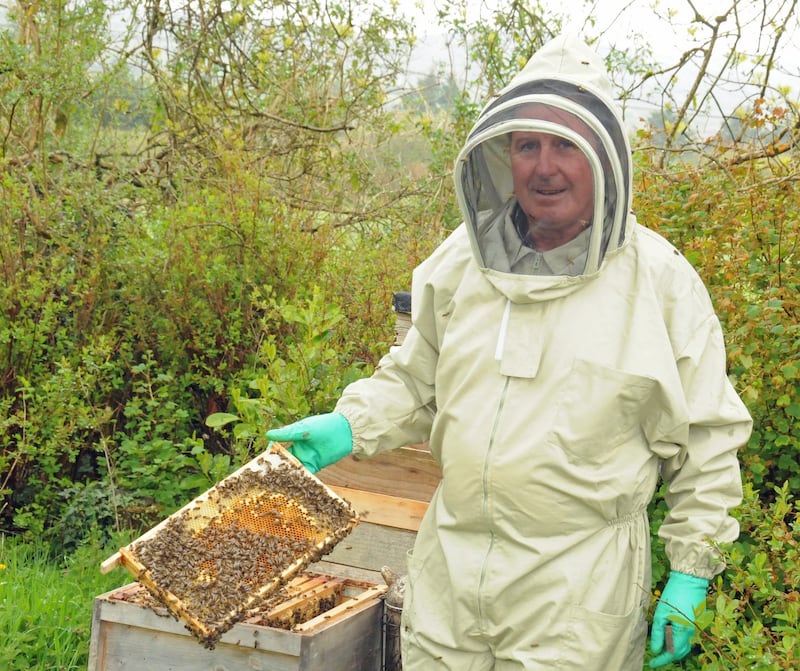Back in the 1950s, says veteran beekeeper Jerry Cronin, the average domestic enthusiast could comfortably manage up to 50 hives in an apiary.
“Today we’re maxing out at about 10 or 12 hives, because forage for the bees is disappearing,” says the retired Eircom field technician who has kept bees for 25 years just outside his hometown of Bantry, Co Cork.
“The hedgerows and wildflowers are all vanishing at an alarming rate. I’m very concerned about it,” says the 63-year-old, who has sold his honey to local cafes and restaurants in west Cork for years.
Part of the problem, he explains, is that modern farming has moved from traditional meadows to pasture, which were managed fields, and from there to modern grassland, where “nothing is left to grow but grass.”
Research has found that bee colonies left untreated will die out in one to three years
The change, he says, started with the advent of bigger agricultural machinery, while at the same time, farmers moved from hay-making to silage-making.
“Hedges were taken down to make room for the machines to work. The fields were left in pasture in order to get one cut of silage a year and then it went to two cuts of silage a year; the first in May, just as the wildflowers came into bloom and the field was denuded by the silage-making.The second cut was in September.”
As a result, he says: “The time frame was not there for wildflowers to come into bloom, and all of that has impacted.”
Things have got so bad, says Cronin, that beekeepers now refer to fields of silage “as ‘green deserts’ because there is no life there. They lack biodiversity.”

Varroa mite
He is also concerned about the impact of agricultural policies that, he warns, do not encourage biodiversity in farmland “in any shape or form”.
“For example, farmers are discouraged from planting hedgerow plants like hawthorn, blackthorn, hazel trees or willow trees, all of which are very beneficial to insect life.”
Add to all of that the impact of the Varroa mite, an external parasitic mite that attacks honeybees, and it’s no wonder Cronin is concerned.
“The virus came into Ireland about 20 years, ago. It arrived in Bantry around 15 years ago. It’s the biggest- known parasite in the animal kingdom.”
It locks on to the bee, he explains, and feeds on the fluid of the bee’s circulatory system, which is similar to blood, spreading disease and reducing the insect’s lifespan.
Without bees or bee pollination it'd be practically impossible for us to produce the food we eat
Research has found that bee colonies left untreated will die out in one to three years. Cronin and other Irish beekeepers used a special pesticide to deal with the mite.
Although he believes the managed honeybee will be fine – “we’re minding them more than ever before” – he and other experts are very concerned for the future of wild bees, such as the bumblebee.
“I notice that a lot of bumblebee species seem to be missing now. They’re not in the fuchsia any more; you can’t help but notice it.”
In Ireland there are 98 different types of bee: the honeybee, 20 different types of bumblebee and 77 different types of solitary bee. In terms of pollination, these bees are aided by other insects such as hoverflies, butterflies and moths.
Dependent on bees
Dr Fiona Edwards Murphy, co-founder of ApisProtect, a company that helps beekeepers reduce losses and increase production, says: “People don’t understand how important bees, especially honeybees, are to humankind because they pollinate so many of the foods we eat – about one-third of the food we eat is dependent on bees.”
Honeybees contribute an estimated €155 billion to the global agrifood industry annually, she adds.
“Without bees or bee pollination it’d be practically impossible for us to produce the food we eat,” says Edwards Murphy, whose company works with beekeepers throughout Ireland, the UK, the US and South Africa.
The Irish agritech innovator has just announced a new partnership with Inmarsat, a global, mobile satellite communications giant, aimed at developing an Internet of Things solution for connected apiaries to help stem the significant decline of bee populations worldwide.
“ApisProtect will provide beekeepers with actionable insights that will brief them on the condition of their hives, identify problem colonies and suggest a variety of actions to keep their colonies healthy and prevent losses, providing a 24-7 early warning system,” she says.
“This also enables them to make earlier interventions in the event of a problem, leading to reduced costs.”











